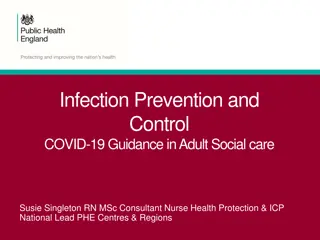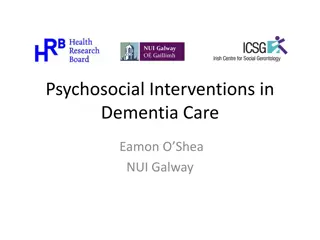Care Partner Burden and Ways to Reduce It
Care partner burden refers to the strain experienced by those caring for chronically ill or elderly family members, leading to negative outcomes such as psychological pain, physical health issues, and financial strains. This burden is more pronounced for spousal care partners who often have little choice in the role. Factors like lower education, living with the care recipient, depression, and social isolation increase the likelihood of developing this burden. To reduce care partner burden, it is essential to partner with doctors, articulate care partner needs, prioritize self-care, educate oneself about the illness, utilize technological support, coordinate assistance, and access respite care.
Download Presentation

Please find below an Image/Link to download the presentation.
The content on the website is provided AS IS for your information and personal use only. It may not be sold, licensed, or shared on other websites without obtaining consent from the author.If you encounter any issues during the download, it is possible that the publisher has removed the file from their server.
You are allowed to download the files provided on this website for personal or commercial use, subject to the condition that they are used lawfully. All files are the property of their respective owners.
The content on the website is provided AS IS for your information and personal use only. It may not be sold, licensed, or shared on other websites without obtaining consent from the author.
E N D
Presentation Transcript
Caring for the Care Partner Liana S. Rosenthal, MD, PhD Associate Professor, Department of Neurology, JHU School of Medicine Director, JHU Ataxia Clinic
Definition Care partner burden: The strain or load borne by a person who cares for a chronically ill, disabled, or elderly family member. Includes personal feelings of carers while performing caring function and events related to negative caring experiences Refers to psychological pain, physical health issues, financial and social strains, impaired family relationships, a sense of hopelessness and other negative outcomes of care tasks
Demographics of care partners In 2009, 65.7 million individuals in the US served as unpaid family care partners Mostly women 20.5 hours per week providing care, with 20% spending more than 40 hours per week Includes basic and instrumental activities of daily living and medical support Care partner also provides emotional support and comfort
Spousal care partners have more challenges More likely to live with the care recipient Have little choice in taking on the role Less aware of the toll it is taking on them More vulnerable because of age and other medical conditions
Things that increase likelihood of developing care partner burden Lower education level Living with the care recipient Depression Financial stress Higher number of hours spent care giving Lack of choice in being a care partner Social isolation
Ways to reduce care partner burden Partner with the doctor to function as a member of the care team Care partner needs should be articulated during doctors visit Improve self-care and maintain your health Educate yourself about the illness Use technological support Coordinate/obtain assistance with care Access/use respite care























